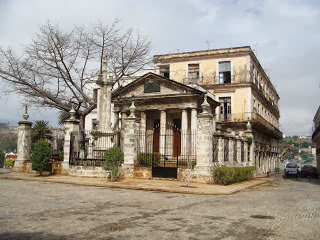Today I
want tell you about one of my favorite places in Havana, El Templete. It´s
my favorite place to talk about this city with tourists in my travels.
The
building situated exactly in front of the Palacio de los Capitanes Generales
(today The City Museum) is a comparatively small building constructed in the
neoclassicist style. Today it is used for commemorative ceremonies marking the
founding of Villa San Cristobal de la Habana (Havana).
This
small Greco-Roman temple was inaugurated on March 19, 1828, in homage to Queen
Josefa Amalia, the wife of Spain’s King Fernando VII.
Inside
were hung three large canvases that represent the holding of the first mass,
the first town council, and a central canvas (painted later) where there
appears the blessing of the site at a mass led by the bishop of Espada in
presence of the General Captain, the aristocracy and high officials of the
colonial government. These works were created by the French painter Jean
Baptiste Vermay, whose remains and those of his wife are in the interior in a
cenotaph made of Carrara marble.
The
paintings have only been taken down on one occasion for restoration.
The
Templete is among the symbols of the city, one of the most beautiful and old
traditions on the island, and served to determine the area that marked the
beginning of the Plaza and Havana when it was founded on the north coast of the
island in 1519.
This
marking of the city was perpetuated first by the planting of a commemorative
Ceiba tree, later by the stone in the Column Cagigal (1754), and after with the
construction of the neoclassical Templete and its interior canvases (1828).
Such monuments attest to this site being the setting of the first mass and
session of town council, both held under the leafy tree.
The
only remnant of the original Ceiba tree is in people’s memories, but now
another equally powerful one has grown and is worshipped by the practitioners
and believers of religions that originated in Africa. Each year on November 16,
thousands of people of different ages, origins, races and sexes turn out to
make three circles around the tree (without stopping to touch it) and to toss
coins at its base while making three wishes.
Only on
that day of the year is this tradition celebrated. It is attracting more and
more people hoping for miracles, though it is now becoming more of a social
event than a religious one.
People
come from all parts of the world from very distant countries. If you’re in Cuba
on that day, don’t miss making three turns around the Ceiba tree, tossing a few
coins and — with much faith — hope for love, health and good luck to accompany
you.
